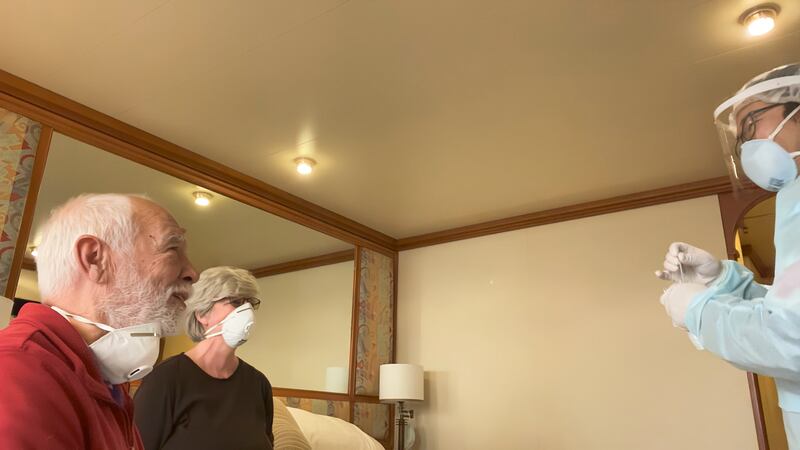On the final evening of a two-week cruise with stops in Hong Kong, Vietnam, Taiwan, and Japan, the 3,700-plus passengers and crew members aboard the Diamond Princess ship received a message from their captain.
“Please be advised that we have been notified that a Hong Kong resident who traveled for five days on Diamond Princess from Yokohama to Hong Kong tested positive for coronavirus,” he announced. “As you can see ladies and gentlemen, the situation is under control and therefore there are no reasons for concerns.”
Yet as history would quickly show, that was far from the case. By the time guests and workers were allowed off the boat after weeks of quarantining, more than 700 people had tested positive for COVID-19 and 14 passengers had died.
HBO’s new documentary The Last Cruise, premiering on March 30 and directed by Hannah Olson, revisits what was described as a “completely chaotic” situation, using footage from cruise guests and crew members who captured how the virus ripped through the ship in real time.
Passengers detail how their cheery and long-awaited vacation quickly became tinged with anxiety and fear of the life-threatening virus. They filmed uneventful days locked inside their cabins, taking nasal swab tests, and their partners being taken to hospitals by doctors in hazmat suits when their COVID tests came back positive.
Meanwhile, crew members take viewers below deck, where workers who were already operating under intense conditions for low pay had to bury their collective panic when the boat went into quarantine, trying their best to keep things running smoothly and the thousands of people onboard fed and healthy.
Olson, who also directed the HBO documentary Baby God about fertility abuser Dr. Quincy Fortier, told The Daily Beast that she had hundreds of hours of footage from passengers and crew to work with when she first began making the film last March.
Drawn to this early pandemic story before the world really knew what this deadly virus would bring, Olson said she sensed something big was about to happen. “No one knew how much our lives would change forever, but I think I knew enough in those early days that the origin story would remain interesting,” she said. “This was the first major COVID-19 outbreak outside of China, so it was kind of the first time we knew that this was maybe coming closer or expanding beyond Wuhan.”
“When I started looking into the story, I realized there was this massive trove of footage from every deck, from every level in the social hierarchy,” Olson added. “I think it became, for me, as much of a story about what happens in a crisis and how we narrate it.”
When the Diamond Princess embarked on its Southeast Asia tour on January 20, there were only four reported cases of COVID outside of China, according to the World Health Organization (WHO). Passengers paid no mind to the virus, and why would they? Princess Cruises ensured guests they would be safe, plus the U.S. government didn’t seem like it was taking the issue too seriously. Two days after the WHO report, former President Donald Trump said the U.S. had the virus “totally under control.”
“It’s going to be just fine,” he assured the American public.
So, cruise guests took advantage of the bustling port cities, filming their vacations as they explored markets and kayaked in idyllic waters. Some even scoffed at local officials who began taking their temperatures and questioning them as they stepped off the vessel. “It was inconveniencing my trip,” one quipped.
While docked in Hong Kong on Chinese New Year, an elderly couple explained they had been cautioned by family members to not get off the boat because of rising COVID case numbers. “We were like, ‘What?’ We really hadn’t heard anything about this,” the guest said. “At that time, we were thinking, [we’re] having that Asian experience wearing a mask! You’d never do that in the United States.”
Footage from onboard shows the boat operated as usual, even when the captain announced on February 3, 2020, that someone had tested positive and was being treated, with the common areas still bustling, dining rooms packed, and entertainers interacting with guests. Even after Japanese health officials boarded the ship to administer COVID tests to passengers, people were allowed out of their rooms and continued on as if everything was normal.
But reality eventually set in and the mood shifted. Guests were told they would be quarantined inside their rooms and began filming their reactions to the steadily growing number of infected passengers onboard. In clips seemingly sent to loved ones, they give updates on the virus and crack wry jokes about the movie Groundhog Day being available to watch on television.
Viewers experience the panic along with the guests, which Olson said was done deliberately. “I wanted it to be an experiential film where the viewer is transported back to the feelings that we all had early on in the pandemic: not knowing what’s happening, denial, confusion, terror.”
“It was really important for me not to include experts in the film,” she continued. “I wanted to limit the information that the viewer had to what was known at the time by those on the boat. The news coverage of the time was fascinating because it’s such an information vacuum and I think that’s part of what was so scary.”
There’s a noticeable difference between the attitudes of the crew workers and the passengers, who still treated their quarantine like an extended vacation. They complained about the dessert and how the room service wasn’t quite up to par. “I could actually sense anxiety with the crew, to me they weren’t as friendly as they were… it was more businesslike,” one traveler said. His wife agreed and chimed in, “They weren’t getting tips anymore.”
But the crew was still working long, grueling shifts and delivering three meals a day to passengers, all while knowing they were being directly put in harm’s way. “We felt like only the rich would be taken care of,” a pastry chef explained. “It’s not only the passengers who are threatened by this virus, so why are we still working?”
That was another draw to the story for Olson, explaining she was curious about how the virus played out in a social aspect. “Cruise ships have such a built-in caste system with passengers and crew, and then even among the crew there’s a hierarchy,” she said. “It was a way for me to look at how this crisis affected people in different social standings in different classes.”

“I was reading that the ship was in quarantine and at the same time the crew was still working, still eating in shared mess halls, sleeping in tightly-packed quarters below the waterline, and delivering 3,000 meals a day. I’m like, ‘Wait, they’re not in quarantine?’ So, who gets to count as being a human being? For me, this became a story about who gets to take shelter, who gets to be in quarantine, and who has to be a human shield,” explained Olson.
She pointed out that despite being entertainers, waiters, pastry chefs, and dishwashers, the crew became “de facto nurses” to take care of the guests, despite never signing up to be put in that position.
“It was wild to me that was almost automatic… it’s assumed,” Olson said. “That experience mirrored what we saw later with so many essential workers. It’s assumed that the grocery store workers will continue to work, because why? Because they need the money. It’s the same on the boat—there was no recourse for anyone because everyone is depending on these jobs. It’s especially the assumption of service from the people who rely on the service jobs.”
One of the most jarring elements of the Diamond Princess story was that it was essentially a case study for how COVID operates and spreads, yet the U.S. government didn’t act on it. It was from the Diamond Princess that scientists and medical experts learned the virus was airborne and that asymptomatic people could still transmit the virus to others.
“The government was telling me to wash my hands, don’t worry about buying masks, [and to] stay home if you’re feeling sick [and] I was watching the CDC board the Diamond Princess in hazmat suits,” she said. “I feel the boat is kind of a microcosm because they’re making some of the same mistakes that we did, just maybe six weeks earlier. If we’d only listened. The information was there, it just wasn’t acted upon.”


